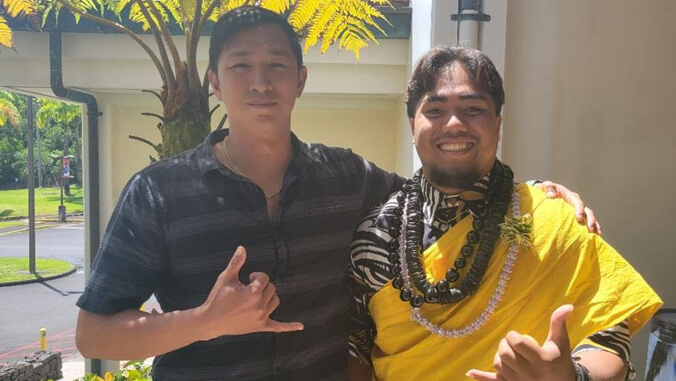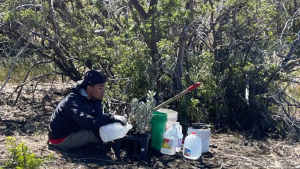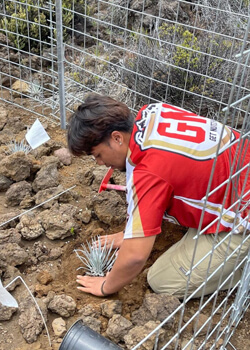
For 10 weeks this summer, undergraduates at the University of Hawaiʻi at Hilo participated in a slew of hands-on, place-based mentorships through the campus’ Pacific Internship Programs for Exploring Science (PIPES). UH Hilo incoming junior Elai Porter’s internship took him more than 13,000 feet above sea level to Maunakea to work at the Center for Maunakea Stewardship (CMS).

Porter assisted CMS with natural resource initiatives focused on alien invertebrate early detection and wēkiu bug monitoring. Both are part of critical surveys CMS land stewards conduct on Maunakea each year.
“Participation in restoration initiatives like wēkiu bug monitoring fosters a sense of connection to not only the ʻāina (land) here but the ʻāina from my own homeland back in Pohnpei and Samoa,” said Porter. “In a broader sense, it allows people to contribute to the preservation of ecosystems, the protection of endangered species, and the overall health of the environment.”
Wēkiu bugs are endemic to Hawaiʻi and the rare insect’s nysius wekiuicola species can only be found on puʻu (cinder cones) on the summit of Maunakea. Every year, CMS places a variety of traps at more than 100 sites on the mauna to assess native species population levels and detect possible threats.
- Related UH News story: More than seven-fold increase in wēkiu bug survey on Maunakea, October 31, 2021
Mālama Maunakea
Porter is considering a career in conservation. This summer’s internship paired him alongside CMS Resource Manager Justin Yeh who also focused on native habitat restoration through the expansion of community volunteer and outreach events.

“Maunakea can serve as a living classroom for students to gain fundamental knowledge in various fields connected to conservation, culture and world-class science,” said Yeh. “Working directly on the mauna can also provide students with core elements of hard work and discipline.”
One of Porter’s many highlights on the mountain was the outplanting of silverswords. To assist CMS’ ongoing effort to restore the highly endangered native species, the natural resource intern worked together with a group of volunteers to plant more than 92 silverswords that he helped raise in the greenhouse. The plants were placed inside an enclosure on the mauna, to create more robust silverswords that can adapt to the different types of microclimates found on Maunakea.
- Related UH News story: CMS raises baby silverswords in Maunakea greenhouse, February 21, 2023
“To be blessed to have that privilege of growing a plant that so many other people haven’t even got to see in person and be able to come back in the future and tell people I grew it, is truly my favorite part,” Porter said.
In August, PIPES hosted a symposium spotlighting student experiences during their summer internships in conservation research, natural resource management, environmental education and more. Porter boiled down his more than two-month internship on Maunakea into the presentation, No ka mālama ana i ka mauna (Embracing values and connections through the stewardship of Maunakea), detailing the importance of collaboration when managing and stewarding public lands.
PIPES is a paid undergraduate summer internship housed within the Office of Research and Community Partnerships at UH Hilo.

